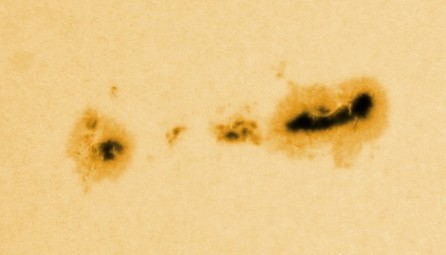The Sun has a fine group of spots making its way across the disk just now. Active region (AR) 1302 is a large group, already associated with auroral activity generated by massive emissions of solar plasma. See Spaceweather for images and information.
Today was mixed sun and cloud in Brisbane, but I took advantage of a clear spell and a moderate temperature to shoot a few more images of our closest star. Once again using the Canon 30D at prime focus on the 150mm Zeiss refractor, I made a few dozen exposures; many are needed, to ensure a few reasonably sharp ones. Bad seeing can affect all astronomical images shot through a telescope, but when the observing conditions are: inside a warm dome, on a warm day, then the turbulence can produce appalling image blur. As it happened, today was just below average for the time of year, with fairly stable seeing - possibly the best I've seen so far, from this site. Even so, exposures around 1/1500 second can still be indistinct, so I increased the ISO setting to 400 and used some exposures of 1/6000 second (as it happened, the best exposures were 1/1500 & 1/2000 second).
In the end, I had 3 usable images, from a total of around 40; I have combined them into a GIF animation. I have also compared them to today's white-light image from the SDO satellite, and was pleasantly surprised. The linked image below will take you to the full set of images.
Today was mixed sun and cloud in Brisbane, but I took advantage of a clear spell and a moderate temperature to shoot a few more images of our closest star. Once again using the Canon 30D at prime focus on the 150mm Zeiss refractor, I made a few dozen exposures; many are needed, to ensure a few reasonably sharp ones. Bad seeing can affect all astronomical images shot through a telescope, but when the observing conditions are: inside a warm dome, on a warm day, then the turbulence can produce appalling image blur. As it happened, today was just below average for the time of year, with fairly stable seeing - possibly the best I've seen so far, from this site. Even so, exposures around 1/1500 second can still be indistinct, so I increased the ISO setting to 400 and used some exposures of 1/6000 second (as it happened, the best exposures were 1/1500 & 1/2000 second).
In the end, I had 3 usable images, from a total of around 40; I have combined them into a GIF animation. I have also compared them to today's white-light image from the SDO satellite, and was pleasantly surprised. The linked image below will take you to the full set of images.

 RSS Feed
RSS Feed